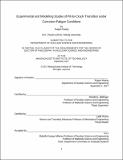| dc.contributor.advisor | Ronald G. Ballinger. | en_US |
| dc.contributor.author | Huang, Xuejun, Ph. D. Massachusetts Institute of Technology | en_US |
| dc.contributor.other | Massachusetts Institute of Technology. Department of Nuclear Science and Engineering. | en_US |
| dc.date.accessioned | 2018-02-16T19:27:04Z | |
| dc.date.available | 2018-02-16T19:27:04Z | |
| dc.date.copyright | 2017 | en_US |
| dc.date.issued | 2017 | en_US |
| dc.identifier.uri | http://hdl.handle.net/1721.1/113720 | |
| dc.description | Thesis: Ph. D., Massachusetts Institute of Technology, Department of Nuclear Science and Engineering, 2017. | en_US |
| dc.description | This electronic version was submitted by the student author. The certified thesis is available in the Institute Archives and Special Collections. | en_US |
| dc.description | Cataloged from student-submitted PDF version of thesis. | en_US |
| dc.description | Includes bibliographical references (pages 184-205). | en_US |
| dc.description.abstract | Corrosion fatigue cracking is a material degradation mechanism which occurs when materials are under cyclic loading and in a corrosive environment. The joint effect of both mechanical and environmental factors makes it one of the most challenging topics in the study of material degradation. The corrosion fatigue cracking process can be separated into four phases, namely development of crack initiation sites (e.g. film breakdown, compositional inhomogeneity, processing variables), development of crack precursors (e.g. pit initiation/growth, grain boundary or localized corrosion), short crack growth and long crack growth. While the mechanism in the long crack growth regime is relatively well understood, the other three regimes are still the subject of much research. The primary goal of this project is to study the transition from the phase 2 to 3, specifically, initiation of cracks from a pit. The material under current investigation is X65 pipeline steel. A galvanostatic method was applied to artificially generate pits on a smooth surface of the material to produce a pitted specimen. The specimen was then cyclically loaded in four-point bending in air, NaCl solution and CO2-saturated NaCl solution at room temperature and 120°C. An alternating current potential drop (ACPD) system was developed and used to detect crack initiation from an existing pit and thus the incubation time to pit-to-crack transition was experimentally obtained. An autoclave system was built in order to apply the desired corrosive environment. Pit-to-crack transition has been successfully captured under fatigue loading and in the environments identified above. Results of experiments in different environments show that the pit-to-crack transition is dominated by a combination of mechanical factors and corrosion processes that facilitate subsequent crack initiation and growth by promoting microstructural barrier removal. A finite element isotropic model with kinematic hardening has been developed to simulate local fatigue ratcheting around the pit up to large strain levels. An approximate value for the plastic strain level at crack initiation was experimentally determined using electron backscatter diffraction (EBSD) techniques. Given the critical strain level, the model can be used to predict the number of cycles of pit-to-crack transition. Based on the experimental and modelling results, the underlying mechanism of pit-to-crack transition under current test conditions is proposed to be local ratcheting around the pit that provides sufficient strain accumulation when coupled to an appropriate corrosive environment. This combination provides the necessary crack "precursors". Environmental effects on crack propagation are also identified and discussed. | en_US |
| dc.description.statementofresponsibility | by Xuejun Huang. | en_US |
| dc.format.extent | 216 pages | en_US |
| dc.language.iso | eng | en_US |
| dc.publisher | Massachusetts Institute of Technology | en_US |
| dc.rights | MIT theses are protected by copyright. They may be viewed, downloaded, or printed from this source but further reproduction or distribution in any format is prohibited without written permission. | en_US |
| dc.rights.uri | http://dspace.mit.edu/handle/1721.1/7582 | en_US |
| dc.subject | Nuclear Science and Engineering. | en_US |
| dc.title | Experimental and modelling studies of pit-to-crack transition under corrosion fatigue conditions | en_US |
| dc.type | Thesis | en_US |
| dc.description.degree | Ph. D. | en_US |
| dc.contributor.department | Massachusetts Institute of Technology. Department of Nuclear Science and Engineering | |
| dc.identifier.oclc | 1021852770 | en_US |
